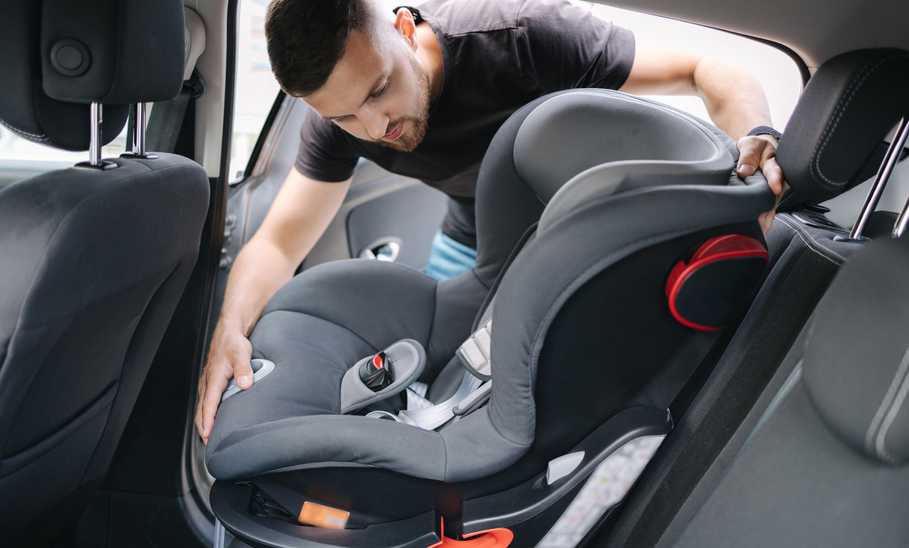Why Do Car Seats Expire? Everything You Need To Know

Our evaluations and opinions are not influenced by our advertising relationships, but we may earn a commission from our partners’ links. This content is created by TIME Stamped, under TIME’s direction and produced in accordance with TIME’s editorial guidelines and overseen by TIME’s editorial staff. Learn more about it.
Car seats have come a long way in safety, style, and functionality. Google a picture of a standard car seat in the year you were born and you’ll be amazed at how you survived—and also grateful modern car seats do have expiration dates. As a mom who’s chill about everything but car seat safety, I’m passionate about spreading awareness on proper usage, which means, yes, you probably shouldn’t use the seat you stored in the garage after your first kid grew out of it for your surprise baby seven years later. And no, you can’t hose it down after a car sick incident without compromising its integrity. Or snag a bougie brand off your local Buy Nothing group without knowing how old it is or the seat’s history.
According to the CDC, children should rear-face from birth until age 2 to 4 and ride in a forward-facing car seat until, at minimum, the age of 5. The typical lifespan of a car seat is around 6 to 10 years, but because many parents pass down car seats to younger children or family and friends, it’s important to know your seat’s expiration date, where to find it, and what you can (and should) do with a car seat once it’s expired. I spoke with a child passenger safety technician (CPST) and the co-founder and CEO of babyark (the only convertible car seat that doesn’t expire), to get the answers to these questions and more.
Child Passenger Safety Technician Juliana Amador of Car Seats & More says, “Car seats have expiration dates to guide their safe and effective lifespan.” Over time, she says materials can degrade due to factors like the following.
“Everyday use can cause straps to loosen, buckles to become worn, and plastics to weaken,” says Amador. Even simple things like kids climbing in and out of the car and holding onto the seat to pull themselves up or cleaning the seat as you struggle to get the cover back on can contribute to wear and tear.
“Exposure to sun, heat, and cold can deteriorate materials, affecting their performance in a crash,” says Amador. “For example, plastic contracts and expands during different seasons like summer or winter prompting the car seat material to weaken.”
“Car seat safety standards and technologies are constantly evolving. Expiration dates help ensure a seat meets current safety recommendations,” explains Amador. Shy Mindel, co-founder and CEO of babyark, agrees. “Expiration dates ensure the seats on the market are up to date as regulations change and car seats become more advanced.”
Car seat expiration dates typically range from six to eight years, and even up to 10 years, from the date of manufacture, but it can vary depending on the manufacturer, notes Amador. (Read this guide to when to switch car seats to know when your child is ready to make the jump to the next type of seat.) Babyark is the only convertible car seat that doesn’t expire, however, the brand does offer a complimentary check-up every 10 years to assess the seat's condition, ensuring it remains reliable and safe to use.
According to The National Highway Traffic Safety Association, car seats should be replaced following any moderate or severe car crash “to ensure a continued high level of crash protection for child passengers.” While car seats don’t automatically need to be replaced after a minor accident, it’s best to check your car seat manual for specific guidance or call the manufacturer directly if you’re unsure how to proceed.
The NHTSA describes a minor crash as one in which ALL of the following apply:
The expiration date on infant car seats and toddler car seats is located somewhere on the car seat itself. “Usually it’s on a label in the bottom or on the back of the seat,” says Mindel. “In some brands, you may find the label underneath the fabric cover,” notes Amador. “The label will usually indicate the date of manufacture and expiration. If you can't locate the label, feel free to call the manufacturer's customer service line. They can help you find it or determine the expiration date of your car seat.”
Yes. “Manufacturers who use expiration dates apply the same to bases,” says Mindel. “Bases often also have separate model numbers and expiration dates, in case they are purchased separately.”
“Yes, booster seats also have expiration dates due to similar material degradation concerns,” informs Amador. Like car seats, an expiration date can be found somewhere on the seat itself, either on a label or stamped directly onto the frame.
No, but experts strongly advise against it. “Most state laws (there is no national law) include clauses requiring ‘proper use’ or ‘used according to manufacturer instructions’,” says Mindel. “Since expirations are included in the instructions, going beyond the expiration date is technically illegal.”
Amador says expired car seats should be retired. “Some manufacturers offer recycling programs. Target's Trade-In event is also a great opportunity to retire an expired car seat.” Otherwise, she recommends checking with your local waste disposal services for proper disposal procedures. If you’re going this route, I highly recommend cutting the car seat straps so no one else can unknowingly use the expired seat.
“In short, car seats don't expire like a carton of milk, but they do have a shelf life,” explains Amador. “They will perform best within the manufacturer's recommended time period. If you consider a used car seat, ensure it's not expired or nearing expiration. Generally, CPSTs don't recommend buying used car seats though due to safety concerns.” You never know if a seat has been recalled, in a moderate or severe accident, or if it was cleaned and cared for properly so it’s best to play it safe and buy new.
Yes, this is the best way to learn about safety issues and product recalls promptly. When you purchase a new car seat, it will come with a registration card parents should immediately fill out with their contact information and mail it back—it costs you nothing and is quick and easy to do. If you misplace the card, purchase a second-hand seat (I generally advise against this), or get a hand-me-down from a trusted friend, you can always visit the manufacturer’s website to register online.
Yes. The babyark convertible car seat is currently the only car seat with no expiration date, though this is only valid with a 10-year complimentary checkup (kind of like a tune-up for your car to ensure all is in working order and safe). The seat is made from non-degradable carbon fiber, steel, and aluminum components. “These materials are chosen for their durability and resistance to degradation, ensuring that the seat's core structure remains sturdy and reliable throughout its lifetime,” says Mindel. “While the outer plastics serve primarily aesthetic purposes and may be susceptible to cosmetic wear, they do not compromise the seat's safety or functionality.”
The seat is even equipped with high-tech crash detection so parents don’t have to guess whether to replace the seat following a crash. The babyark app will alert you that the car seat has been in a collision and needs to be replaced, and the top shell of the base and the bottom shell will no longer align—a visual indication you need a new seat.
“In the case of a side impact accident, the side impact protection wing will activate, and if the wing has been pushed in and is no longer able to fold in (stuck in place), the seat has experienced a more than minor side impact and needs to be replaced,” adds Mindel. As car seat regulations and requirements change, babyark also alerts customers via its app to inform them regarding any critical changes and updates.
Whether you own a popular car seat stroller combo like the Doona, which gets regular use outside your vehicle, or plan on having more kids and just don’t want to spend more money on another car seat, taking good care of your seat is essential for your child’s safety. To ensure your car seat holds up over the years and properly protects your child (or their sibling) from the day you get it through expiration, it’s best to:
The information presented here is created by TIME Stamped and overseen by TIME editorial staff. To learn more, see our About Us page.



